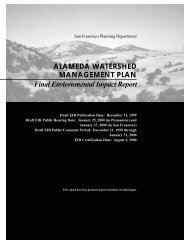Feasibility of Fish Passage at Alameda Creek Diversion Dam
Feasibility of Fish Passage at Alameda Creek Diversion Dam
Feasibility of Fish Passage at Alameda Creek Diversion Dam
You also want an ePaper? Increase the reach of your titles
YUMPU automatically turns print PDFs into web optimized ePapers that Google loves.
4.0 Design Components and Preliminary Analysisneed for NMFS approval. Several install<strong>at</strong>ions loc<strong>at</strong>ed in the Pacific Northwest are currently beingreviewed and evalu<strong>at</strong>ed by NMFS to determine whether they have the potential to harm emigr<strong>at</strong>ingjuvenile and post-spawn adult steelhead th<strong>at</strong> may travel across the screen during low flow conditions.As with all <strong>of</strong> the other screen types, a fish bypass would be required <strong>at</strong> the end <strong>of</strong> the screen to returndebris and emigr<strong>at</strong>ing steelhead downstream. A schem<strong>at</strong>ic diagram <strong>of</strong> a downward-sloping horizontalfl<strong>at</strong>-pl<strong>at</strong>e screen is depicted in Figure 4-12.Figure 4-12Horizontal Downward-Sloping Fl<strong>at</strong> Pl<strong>at</strong>e ScreenAs shown in Figure 4-12, a horizontal fl<strong>at</strong>-pl<strong>at</strong>e screen oper<strong>at</strong>es by allowing a percentage <strong>of</strong> the flowover the screen to pass through it. The flow th<strong>at</strong> passes through the screen falls into a canal below thescreen where it is routed as required. Oper<strong>at</strong>ion <strong>of</strong> this screen is very sensitive to the minimum depth<strong>of</strong> surface w<strong>at</strong>er bypassing the diversion. Normally a minimum depth <strong>of</strong> 12 inches is required(WDFW, 2000a).An advantage <strong>of</strong> the downward-sloping horizontal screens is th<strong>at</strong>, if designed properly, they areinherently self-cleaning as debris is removed by the normal stream flow. Disadvantages include thepotential for non-uniform approach velocities across the screen, sensitivity to fluctu<strong>at</strong>ing forebayelev<strong>at</strong>ions, and the “experimental” n<strong>at</strong>ure as defined by NMFS. For these reasons, this type <strong>of</strong> screenis not analyzed further for use <strong>at</strong> ACDD in this report.4.4.2 POTENTIAL SCREEN CONFIGURATIONSAs described in Section 4.4.1, vertical/inclined fl<strong>at</strong>-pl<strong>at</strong>e screens and vertical traveling screens mayboth be suitable for use <strong>at</strong> ACDD. For the purposes <strong>of</strong> this analysis, only vertical or inclined fl<strong>at</strong>pl<strong>at</strong>escreens have been carried forward. These types are used widely and typically cost less thantraveling screens. Vertical fl<strong>at</strong>-pl<strong>at</strong>e screens could be installed in several configur<strong>at</strong>ions <strong>at</strong> ACDD.For each type, it is necessary to carefully consider how sweeping velocity and approach velocity canbe kept uniform across the face <strong>of</strong> the screen and how effective oper<strong>at</strong>ion <strong>of</strong> the fish bypass facilitycan be maintained throughout the range <strong>of</strong> forebay fluctu<strong>at</strong>ions. In this section, two conceptual-levelscreen configur<strong>at</strong>ions have been identified to protect steelhead from entrainment <strong>at</strong> the ACDT intake.Each screen configur<strong>at</strong>ion will require modific<strong>at</strong>ion <strong>of</strong> the existing diversion structure in order to beeffective. For purposes <strong>of</strong> this discussion, the area behind the existing trash racks and fish screen isreferred to as the sediment channel. Two potential configur<strong>at</strong>ions are shown in Figures 4-13and 4-14:ACDD <strong>Passage</strong> June 2009 Page 4-21








